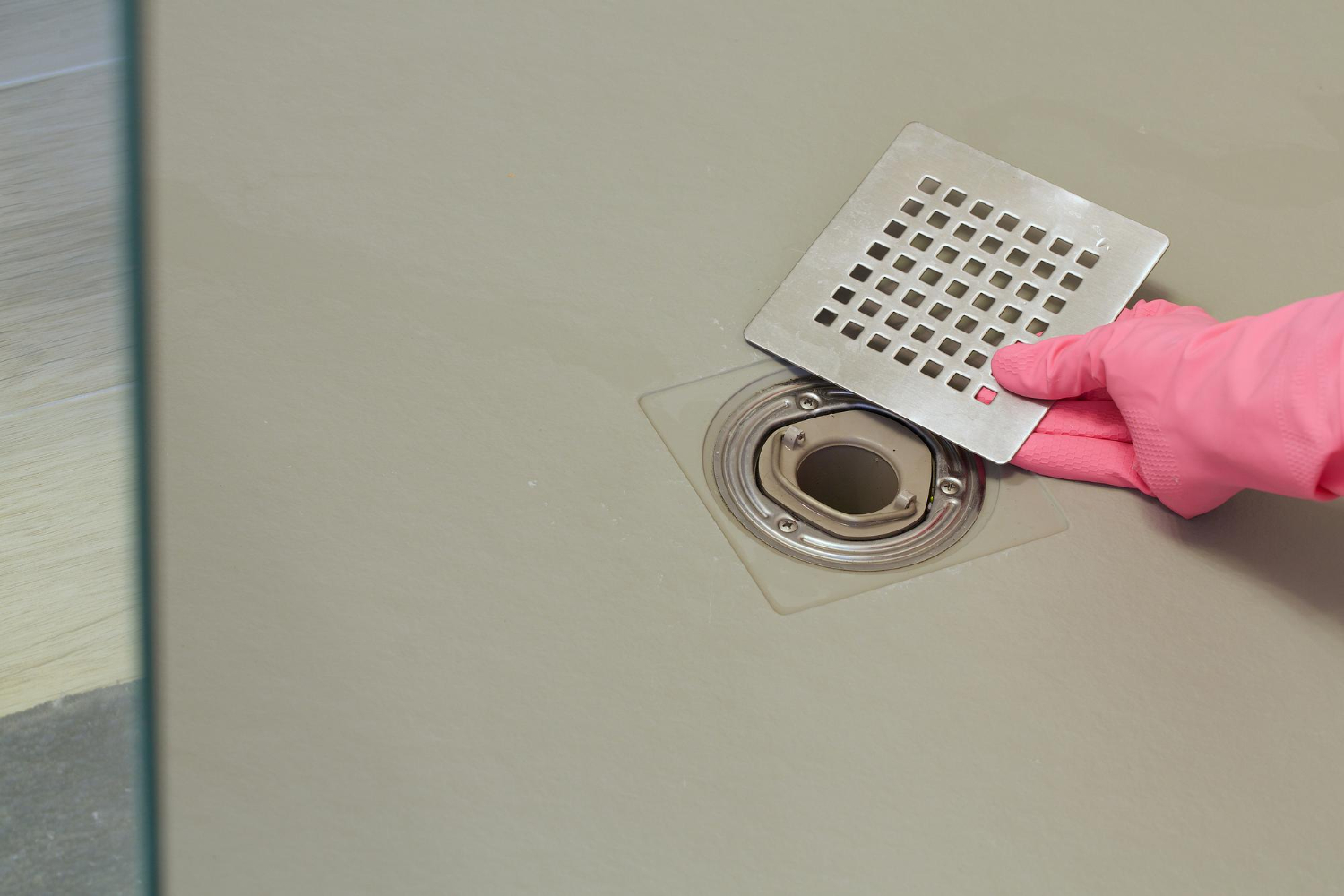


FREE Water Heater
With every whole house repipe purchase. Free brand-new water heater or credit towards a tankless water heater.
.svg)
.svg)
.svg)
.svg)



With every whole house repipe purchase. Free brand-new water heater or credit towards a tankless water heater.
.svg)
.svg)
.svg)
.svg)

Knowing how do you unclog shower drain can save you from a frustrating mess with water pooling around your feet. We can fix most shower drain clogs using simple household items like baking soda, vinegar, and basic tools you already have at home. These safe methods work well for common blockages caused by hair, soap scum, and debris.
We'll walk you through proven techniques that clear clogs without damaging your pipes or requiring expensive chemicals. From understanding what causes these blockages to learning when you might need professional help, we'll cover everything you need to know.
Here's what you'll find below:
Keep reading! Our step-by-step approach includes prevention tips that will keep your shower drain flowing smoothly for months to come. These methods can save you time and money while keeping your bathroom functional.
Shower drains clog when hair, soap, and other materials build up inside the pipes over time. Understanding these common causes helps us take steps to prevent problems before they start.
Hair buildup is the main reason shower drains get blocked. Every time we shower, loose hair falls and sticks to the sides of the drain pipe.
Over weeks and months, this hair forms a thick mat. The mat catches other materials like dead skin and soap pieces.
Soap residue creates another major problem. Bar soap and body wash leave behind a film that hardens inside pipes.
This soap film mixes with minerals from hard water. The combination creates a thick, sticky coating on pipe walls.
Body oils and shampoo also contribute to clogs. These products don't wash away completely and stick to existing buildup.
Small items like bottle caps or razor guards can fall down the drain. These objects block water flow and catch more debris.
EPA data confirms that showering accounts for nearly 17% of residential indoor water use, which equates to almost 40 gallons per day per family, reinforcing shower system maintenance importance.
Regular shower drain cleaning stops clogs before they form. We should clean our drains once a week with simple steps.
Pour hot water down the drain weekly to wash away soap and oils. Use the hottest water your pipes can handle safely.
Remove visible hair from the drain opening after each shower. Pull out any hair you can see with your fingers or tweezers.
Use a drain cover or hair catcher to stop hair from going down the drain. Clean these covers weekly to keep them working well.
Mix baking soda and vinegar once a month for deeper cleaning. Use 1/3 cup of each and pour the mixture down the drain.
Brush the drain opening with an old toothbrush to remove soap buildup. Focus on the edges where residue collects most.
Slow drain fix becomes necessary when we notice these warning signs in our daily routines.
Water pools around our feet during showers instead of draining quickly. This shows the drain is partially blocked.
Bad smells come from the drain opening. These odors happen when soap and hair start to rot inside the pipes.
Gurgling sounds occur when water goes down the drain. This noise means air is trapped by the clog.
Gainesville homes often have hard water that makes soap residue problems worse. The minerals in hard water react with soap to create more buildup.
We might see water backing up into the shower after using other drains in the house. This means the main drain line has problems.
Fruit flies or small bugs appear near the drain. These insects are attracted to the rotting materials stuck in clogged pipes.
Three simple methods can clear most shower drain clogs using items you already have at home. These techniques work well for hair blockages and soap buildup without harsh chemicals.
Hair clogs are the most common reason shower drains get blocked. We can remove these clogs using basic tools and our hands.
Start with your fingers first. If you can see hair near the drain opening, reach in and pull it out. This simple step often solves the problem right away.
Use a drain snake for deeper clogs. A plumbing snake can reach hair that sits further down the pipe. Push the snake into the drain and twist it to catch the hair. Pull it back out slowly.
Try a wire coat hanger as an alternative. Straighten a coat hanger and create a small hook at one end. Fish this down the drain to grab hair clogs.
Remove the drain cover if needed. Some hair clogs sit just under the drain cover. Take off the cover to get better access to the blockage.
A plunger can also help push hair clogs through the pipes when other methods don't work.
Vinegar and baking soda create a fizzing reaction that helps break down soap scum and small clogs. This natural method is safe for most pipes.
Mix the ingredients in the right order. Pour 1 cup of white vinegar down the drain first. Then add 2 tablespoons of baking soda.
Add more vinegar to boost the reaction. Pour another cup of vinegar into the drain after adding the baking soda. This makes the fizzing action stronger.
Wait for the mixture to work. Let the vinegar and baking soda sit in the drain for 15 to 30 minutes. The bubbling action helps loosen buildup.
Flush with hot water. Run hot water down the drain to wash away the loosened debris. This final step completes the cleaning process.
We can also mix equal parts vinegar and baking soda in a heat-resistant cup before pouring it down the drain.
Boiling water can help clear shower drains, but it works best for certain types of clogs and pipe materials.
Boiling water melts soap buildup effectively. Hot water dissolves soap scum that sticks to pipe walls. This method works well for minor clogs caused by soap residue.
Check your pipe type before using boiling water. Make sure your pipes can handle very hot water. Older pipes or certain materials might get damaged by boiling water.
Pour the water slowly and carefully. Boil a full kettle of water and pour it down the drain in a steady stream. The heat helps break apart grease and soap.
Combine with other methods for better results. Boiling water works best when used after removing hair clogs or using vinegar and baking soda. Use it as a final rinse step.
This method won't work well for solid blockages like large hair clogs, but it helps maintain clean pipes.
We need the right tools and safety steps to clear shower drain clogs without damage. Proper drain cover removal and avoiding common mistakes help us fix the problem quickly.
We need basic safety gear before starting any DIY unclog shower project. Rubber gloves protect our hands from germs and debris. Safety glasses keep soap scum and water from splashing in our eyes.
Essential cleaning tools make the job easier:
Tool
Purpose
Needle-nose pliers
Remove hair clogs
Flathead screwdriver
Lift drain covers
Small flashlight
See inside dark drains
Drain snake
Clear deep blockages
Cup plunger
Create pressure to push clogs
We should have cleaning supplies ready too. Baking soda and white vinegar work well together. A kettle for boiling water helps flush the drain after cleaning.
Old towels placed around the shower catch spills and debris. We can use a small bucket to collect hair and soap scum we pull out.
We start by turning off the water and clearing the shower area. Good lighting helps us see small screws or clips that hold the drain cover.
Most drain covers lift off easily. We slide a flathead screwdriver under one edge and gently pry up. Some covers have screws in the corners that we need to remove first.
Important safety tip: We take a photo of the drain cover before removing it. This helps us remember how it fits back together.
We check what type of drain cover we have:
After cleaning, we reassemble the drain cover by reversing these steps. We make sure the cover sits flat and secure. Loose covers can fall into the drain and create bigger problems.
We should never pour boiling water down PVC pipes. The hot water can soften and damage plastic pipes. Warm water works just as well for most clogs.
Mixing different chemicals creates dangerous fumes. We stick to one cleaning method at a time. If baking soda and vinegar don't work, we try a drain snake next.
Using too much force damages pipes and drain covers. We work slowly and gently when removing hair clogs. Patience prevents expensive repairs.
We avoid these common errors:
Never use a coat hanger as a drain snake. The sharp edges can scratch pipes and the hook can break off inside the drain.
Some shower drain clogs are too tough for basic home methods to handle. Professional plumbers have specialized tools and experience to tackle deep blockages that keep coming back.
Multiple drain backups signal a serious problem in your main sewer line. When water backs up in several drains at once, we need professional help right away.
Recurring clogs that return within days or weeks indicate deeper issues. If we've tried plunging, snaking, and cleaning multiple times without lasting results, the problem likely sits far down the pipes.
Sewage odors coming from shower drains suggest blockages in the main line. These smells can mean dangerous gases are building up in our plumbing system.
Slow drainage that doesn't improve after trying home methods often means stubborn clogs are packed deep in the pipes. Hair, soap buildup, and debris can create solid masses that basic tools can't reach.
Water backing up into other fixtures when we use the shower means the blockage affects multiple parts of our plumbing system.
Professional plumbers use high-powered equipment that removes clogs we can't reach with basic tools. Drain snakes that extend 50-100 feet can break through deep blockages.
Video inspection cameras let plumbers see exactly where clogs sit and what's causing them. This prevents guesswork and ensures they target the right area.
Hydro-jetting services blast away years of buildup using high-pressure water streams. This method clears pipes completely and prevents future clogs better than chemical cleaners.
Safe chemical treatments that professionals use won't damage our pipes like store-bought drain cleaners can. Plumbers know which products work best for different types of clogs.
Guaranteed results mean we don't waste time and money on methods that might not work. Professional drain cleaning typically comes with warranties on the work performed.
Gainesville plumbers, like Sunshine Services, start with drain cameras to locate exactly where stubborn clogs sit in the pipes. This technology shows the size and type of blockage before they begin work.
Motorized drain snakes with cutting heads break through packed hair and soap buildup that manual tools can't handle. These machines can reach 100 feet into sewer lines.
Hydro-jetting equipment shoots water at 4,000 PSI to blast away years of accumulated debris. This method works especially well for recurring clogs caused by soap scum and mineral deposits.
For tree root intrusions, local plumbers use specialized cutting tools that slice through roots without damaging pipes. They can also apply root-killing chemicals to prevent regrowth.
Pipe replacement services handle cases where old pipes have collapsed or developed major cracks that cause repeated backups.
According to the EPA, most households use around 400 gallons of water daily, and since 70% of this use happens indoors, much of it in bathrooms, it’s clear that keeping shower drains clear is essential to prevent inefficient water use.
Stopping clogs before they start saves time and money. Regular care keeps water flowing smoothly and prevents major blockages.
We should clean our shower drains weekly to prevent buildup. Remove visible hair and soap scum from the drain cover every time we shower.
Weekly cleaning routine:
Monthly deep cleaning helps remove hidden buildup. We can use baking soda and vinegar to break down soap scum and oil.
Mix half a cup of baking soda with half a cup of white vinegar. Pour this mixture down the drain and let it sit for 15 minutes. Follow with hot water to flush everything away.
Never pour these items down shower drains:
Drain screens catch hair before it goes down the pipe. We should install mesh screens or hair catchers in every shower drain.
Types of drain screens:
Clean the screen after each shower. Remove trapped hair and rinse with warm water.
Replace screens every 3-6 months depending on use. Worn screens let debris pass through and lose their effectiveness.
We can find drain screens at hardware stores for $5-15. This small cost prevents expensive plumber visits later.
Deep seasonal cleaning stops small problems from becoming big ones. We should inspect and clean our drains four times per year.
Spring cleaning tasks:
Summer brings more shower use from swimming and outdoor activities. We need to clean screens more often during busy months.
Fall preparation includes removing leaves or debris that might enter bathroom vents. Check that drain covers fit tightly.
Winter maintenance focuses on preventing freezing in cold areas. Keep drains flowing to prevent ice buildup in pipes.
Signs we need professional help:
We've covered several proven methods to unclog your shower drain at home. These simple techniques work for most common blockages.
The natural cleaning approach works well for minor clogs. Mix half a cup of baking soda with vinegar. Let it sit for 30-60 minutes before rinsing.
Safety remains important when trying these methods. Always wear rubber gloves. Be careful with boiling water to avoid burns.
Most shower drain problems happen because of hair buildup. Regular cleaning prevents major blockages from forming.
If these home methods don't work after two attempts, the clog might be deeper in your pipes. This means you may need professional help.
These methods save money compared to calling a plumber right away. They also avoid harsh chemicals that can damage your pipes.
Remember to clean your drain regularly. This prevents future clogs from happening. Simple maintenance keeps water flowing smoothly.
Schedule a professional shower drain cleaning in Gainesville if DIY methods don’t work or if slow drains keep returning.